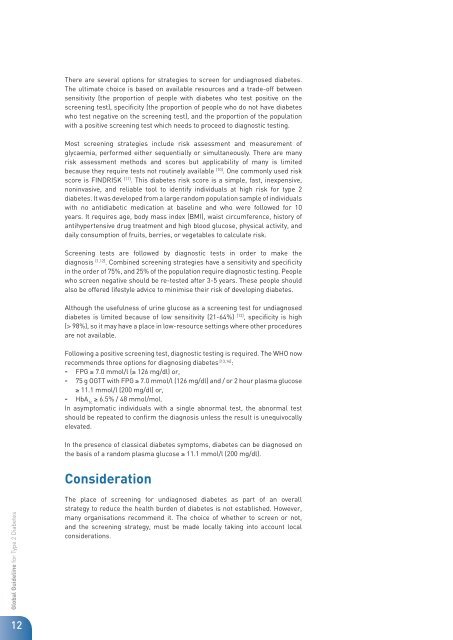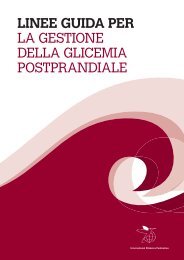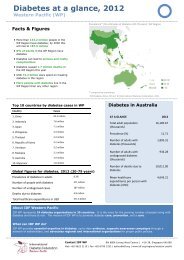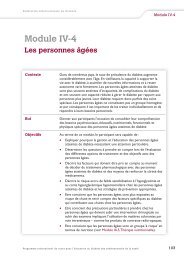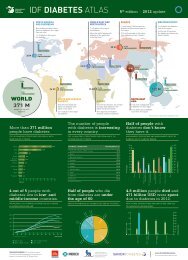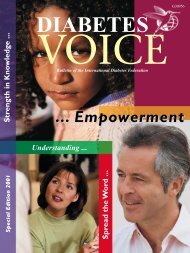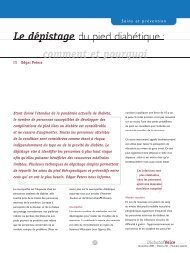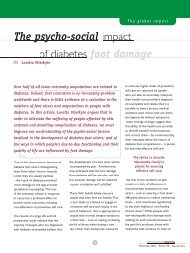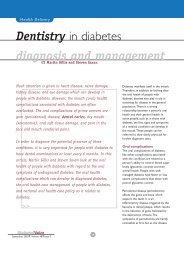Evidence-base - International Diabetes Federation
Evidence-base - International Diabetes Federation
Evidence-base - International Diabetes Federation
Create successful ePaper yourself
Turn your PDF publications into a flip-book with our unique Google optimized e-Paper software.
Global Guideline for Type 2 <strong>Diabetes</strong><br />
12<br />
There are several options for strategies to screen for undiagnosed diabetes.<br />
The ultimate choice is <strong>base</strong>d on available resources and a trade-off between<br />
sensitivity (the proportion of people with diabetes who test positive on the<br />
screening test), specificity (the proportion of people who do not have diabetes<br />
who test negative on the screening test), and the proportion of the population<br />
with a positive screening test which needs to proceed to diagnostic testing.<br />
Most screening strategies include risk assessment and measurement of<br />
glycaemia, performed either sequentially or simultaneously. There are many<br />
risk assessment methods and scores but applicability of many is limited<br />
because they require tests not routinely available [10] . One commonly used risk<br />
score is FINDRISK [11] . This diabetes risk score is a simple, fast, inexpensive,<br />
noninvasive, and reliable tool to identify individuals at high risk for type 2<br />
diabetes. It was developed from a large random population sample of individuals<br />
with no antidiabetic medication at <strong>base</strong>line and who were followed for 10<br />
years. It requires age, body mass index (BMI), waist circumference, history of<br />
antihypertensive drug treatment and high blood glucose, physical activity, and<br />
daily consumption of fruits, berries, or vegetables to calculate risk.<br />
Screening tests are followed by diagnostic tests in order to make the<br />
diagnosis [1,12] . Combined screening strategies have a sensitivity and specificity<br />
in the order of 75%, and 25% of the population require diagnostic testing. People<br />
who screen negative should be re-tested after 3-5 years. These people should<br />
also be offered lifestyle advice to minimise their risk of developing diabetes.<br />
Although the usefulness of urine glucose as a screening test for undiagnosed<br />
diabetes is limited because of low sensitivity (21-64%) [12] , specificity is high<br />
(> 98%), so it may have a place in low-resource settings where other procedures<br />
are not available.<br />
Following a positive screening test, diagnostic testing is required. The WHO now<br />
recommends three options for diagnosing diabetes [13,14] :<br />
- FPG ≥ 7.0 mmol/l (≥ 126 mg/dl) or,<br />
- 75 g OGTT with FPG ≥ 7.0 mmol/l (126 mg/dl) and / or 2 hour plasma glucose<br />
≥ 11.1 mmol/l (200 mg/dl) or,<br />
- HbA 1c ≥ 6.5% / 48 mmol/mol.<br />
In asymptomatic individuals with a single abnormal test, the abnormal test<br />
should be repeated to confirm the diagnosis unless the result is unequivocally<br />
elevated.<br />
In the presence of classical diabetes symptoms, diabetes can be diagnosed on<br />
the basis of a random plasma glucose ≥ 11.1 mmol/l (200 mg/dl).<br />
Consideration<br />
The place of screening for undiagnosed diabetes as part of an overall<br />
strategy to reduce the health burden of diabetes is not established. However,<br />
many organisations recommend it. The choice of whether to screen or not,<br />
and the screening strategy, must be made locally taking into account local<br />
considerations.


